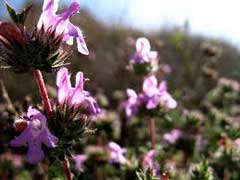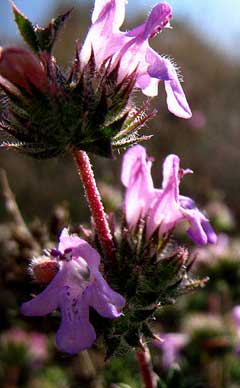 |
|
/www.flickr.com/photos/sarahfaulwetter |
 |
| /www.flickr.com/photos/sarahfaulwetter |
Translate this page:
Summary
Cretan Savory or Roman Hyssop (S. thymbra) leaves have a peppery, thyme-like flavour. A strong herb infusion is used in the autumn to clean wine barrels in preparation for the new vintage. An essential oil is obtained from the plant, it contains 19% thymol and is also rich in carvacrol.
Physical Characteristics

 Satureja thymbra is a SHRUB growing to 0.4 m (1ft 4in) by 0.4 m (1ft 4in) at a medium rate.
Satureja thymbra is a SHRUB growing to 0.4 m (1ft 4in) by 0.4 m (1ft 4in) at a medium rate.
See above for USDA hardiness. It is hardy to UK zone 7. It is in flower from May to June. The species is hermaphrodite (has both male and female organs). The plant is self-fertile.
It is noted for attracting wildlife.
Suitable for: light (sandy), medium (loamy) and heavy (clay) soils. Suitable pH: mildly acid, neutral and basic (mildly alkaline) soils. It can grow in semi-shade (light woodland) or no shade. It prefers moist soil.
UK Hardiness Map
US Hardiness Map
Synonyms
Plant Habitats
Cultivated Beds; East Wall. In. South Wall. In. West Wall. In.
Edible Uses
Edible Parts: Shoots
Edible Uses: Condiment Tea
The leaves have a thyme-like flavour and are used as a seasoning for pulses, savoury breads, brine-cured olives, vegetables etc[4, 177, 183, 238]. The leaves and young shoots are used as a tea substitute. It is said that this make one of the best-tasting of all herb teas[183].
References More on Edible Uses
Medicinal Uses
Plants For A Future can not take any responsibility for any adverse effects from the use of plants. Always seek advice from a professional before using a plant medicinally.
Antibacterial Aromatic Digestive Expectorant Tonic
The leaves are antibacterial, aromatic, digestive, expectorant and tonic[148, 238]. They are used internally to treat minor digestive discomfort and bronchial congestion[238]. The leaves are harvested during the growing season and can be used fresh or dried[238].
References More on Medicinal Uses
The Bookshop: Edible Plant Books
Our Latest books on Perennial Plants For Food Forests and Permaculture Gardens in paperback or digital formats.

Edible Tropical Plants
Food Forest Plants for Hotter Conditions: 250+ Plants For Tropical Food Forests & Permaculture Gardens.
More

Edible Temperate Plants
Plants for Your Food Forest: 500 Plants for Temperate Food Forests & Permaculture Gardens.
More

More Books
PFAF have eight books available in paperback and digital formats. Browse the shop for more information.
Shop Now
Other Uses
Cleanser Essential
A strong infusion of the herb is used in the autumn to clean wine barrels in preparation for the new vintage[183]. An essential oil is obtained from the plant, it contains 19% thymol[4] and is also rich in carvacrol[238]. It is used in the pharmaceutical industry[238]. A good bee plant[148]. Members of this genus are rarely if ever troubled by browsing deer[233]. Dynamic accumulator.
Special Uses
Attracts Wildlife Dynamic accumulator Scented Plants
References More on Other Uses
Cultivation details
Requires a sunny position in a well-drained soil[200]. Plants are intolerant of soils that remain damp[200]. Prefers a neutral to alkaline soil[238]. This species is not very hardy outdoors in Britain, plants suffer damage at temperatures below freezing but they can be grown as annuals, flowering and setting seed in their first year[200]. Plants will be hardier in soils that are very well drained and also if the soil is a bit on the poor side[K].
References Carbon Farming Information and Carbon Sequestration Information
Temperature Converter
Type a value in the Celsius field to convert the value to Fahrenheit:
Fahrenheit:
The PFAF Bookshop
Plants For A Future have a number of books available in paperback and digital form. Book titles include Edible Plants, Edible Perennials, Edible Trees,Edible Shrubs, Woodland Gardening, and Temperate Food Forest Plants. Our new book is Food Forest Plants For Hotter Conditions (Tropical and Sub-Tropical).
Shop Now
Plant Propagation
Seed - surface sow in April in a greenhouse. Do not allow the compost to dry out. Germination can be slow and erratic[1] but usually takes place within a month[K]. Prick out the seedlings into individual pots as soon as they are large enough to handle. It is usually possible to plant out into their permanent positions during the summer, but if the plants have not grown sufficiently, or if you live in an area of cold winters, it might be best to grow them on in a cold frame for their first winter and plant them out in late spring or early summer of the following year[K]. Cuttings of half-ripe wood, 5 - 8cm taken at a node, July/August in a frame. Pot up in autumn and overwinter in a frame, planting out in late spring or early summer of the following year. A high percentage usually succeed[78]. Cuttings of young wood, preferably with a heel, April/May in a frame[1, 37]. Plant out in the summer if the plants grow well, otherwise overwinter them in a cold frame and plant out in late spring or early summer of the following year[K]. Division in early spring as growth commences[78, 200]. This works best if soil has been mounded up into the bottom 20cm of the plant early in the previous summer[78]. Pot up the divisions and grow them on in a cold frame until they are established. Plant them out in the summer.
Other Names
If available other names are mentioned here
Native Range
Cyprus, East Aegean Is., Greece, Kriti, Lebanon-Syria, Libya, Palestine, Sardegna, Turkey, Turkey-in-Europe
Weed Potential
Right plant wrong place. We are currently updating this section.
Please note that a plant may be invasive in one area but may not in your area so it's worth checking.
Conservation Status
IUCN Red List of Threatened Plants Status :

Growth: S = slow M = medium F = fast. Soil: L = light (sandy) M = medium H = heavy (clay). pH: A = acid N = neutral B = basic (alkaline). Shade: F = full shade S = semi-shade N = no shade. Moisture: D = dry M = Moist We = wet Wa = water.
Now available:
Food Forest Plants for Mediterranean Conditions
350+ Perennial Plants For Mediterranean and Drier Food Forests and Permaculture Gardens.
[Paperback and eBook]
This is the third in Plants For A Future's series of plant guides for food forests tailored to
specific climate zones. Following volumes on temperate and tropical ecosystems, this book focuses
on species suited to Mediterranean conditions—regions with hot, dry summers and cool, wet winters,
often facing the added challenge of climate change.
Read More
Expert comment
Author
L.
Botanical References
50200
Links / References
For a list of references used on this page please go here
Readers comment
© 2010, Plants For A Future. Plants For A Future is a charitable company limited by guarantee, registered in England and Wales. Charity No. 1057719, Company No. 3204567.